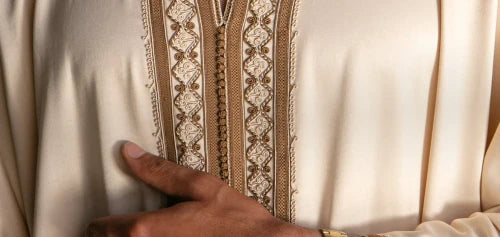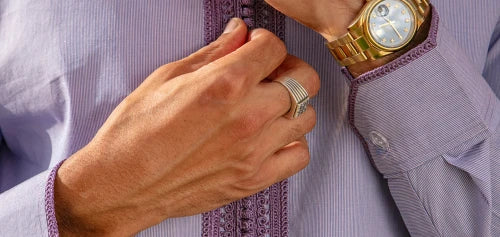The Gandora, often referred to as a Kandora or Gandoura, is a quintessential garment in Moroccan attire. Traditionally, it is a short sleeved tunic that extends from the shoulders to the ankles, designed for both indoor and outdoor wear. This versatility ensures that Moroccans can enjoy its comfort throughout their daily activities.
Often recognized for its elegance and versatility, the Gandora is a traditional outfit that embodies centuries of Moroccan history and craftsmanship. This blog post will unravel the essence of the Moroccan Gandora, explore its various styles, and highlight how it uniquely caters to both men and women.
History of the Gandora
Moroccan fashion is a vibrant tapestry woven from diverse cultural influences. While many people might not realize it, the Moroccan dress code has been shaped by a rich history of interactions with the Persians, Andalusians, Romans, and Turks. This eclectic blend of influences, combined with Morocco's Islamic heritage and connections to Spain, creates a fashion landscape as varied and rich as its history.
The origins of the Gandora can be traced back to ancient Moroccan history, where it was influenced by a blend of Berber, Arab, and Andalusian cultures. Initially worn for its practicality in Morocco's diverse climates, the Gandora has evolved to become a symbol of Moroccan heritage and identity. Its design and embellishments reflect the craftsmanship of Moroccan artisans and the regional influences that have shaped Moroccan fashion over the centuries.
In traditional settings, the Gandora is more than just clothing; it represents a connection to Moroccan customs and values. For many Moroccans, wearing a Gandora is a way of honoring their cultural roots and participating in the timeless practices of their ancestors.
This fusion of cultural influences highlights Morocco's ability to embrace and adapt various styles while maintaining its unique identity. The Gandora stands as a testament to this dynamic cultural exchange, embodying centuries of tradition and fashion evolution. In exploring the Moroccan Gandora, we delve into a garment that not only represents the country's historical richness but also showcases its ongoing dialogue with the broader world.
Where Can you Wear a Gandora
During the summer - During the summer, the Gandora is typically worn on its own over shorts or swimwear. Men will wear it on its own without the outer djellaba, and women will wear them at home allowing for greater breathability and ease.

Image source: Pinterest.com
For Friday Prayer - Moroccans will generally wear a smart Gandora to the Friday congregational prayer in the Mosque. During this special day of the week, Muslim men will make ghusl, (a special bath/shower ritual), clip their nails, dress smartly and wear some fragrance. This was done by the beloved prophet Muhammad (pbuh) and is practised by all Muslim men to this day.
During a Wedding or Special Occasions - Both men and women will wear special party Gandoras for special occasions such as weddings and Eid. This type of Gandora will be made with more expensive fabrics and for women, it will be heavier in embroidery and beading.

Despite the pressures of globalization and the trend towards standardized fashion that often threatens to overshadow traditional styles, Morocco remains resilient. Both, Moroccan men and women continue to embrace and preserve its unique sartorial heritage, with the Gandora being a prominent example of this resistance.
Whether for daily wear or special occasions, the Gandora remains a beloved choice, reflecting both the practicality and the enduring cultural significance of Moroccan fashion.
Different Types of Gandora Fashion

A selection of women's classic Gandora's for everyday summer wear.
-
The Classic Gandora: This style is simple and comfortable, often made from cotton or linen. It typically features simple embellishment and a straight cut, making it ideal for everyday wear. The classic Gandora is often worn by men and women in a variety of settings, such as the beach, quick errands or home wear.
-
Embroidered Gandora: Known for its intricate embroidery, this style adds a touch of opulence to the traditional Gandora. The embroidery, often done in gold or silver thread, is usually concentrated around the neckline and cuffs. This type of Gandora is typically worn for special occasions such as weddings or religious ceremonies.
-
Modern Gandora: In contemporary fashion, the Gandora has seen a range of modern adaptations. Designers have experimented with fabrics, cuts, and colours, incorporating elements like zippers, asymmetrical designs, and vibrant prints. The modern Gandora is a reflection of current fashion trends while still maintaining its cultural roots.
-
Seasonal Variations: The Gandora also varies according to the season. For cooler months, heavier and warmer fabrics are preferred, while lighter cotton and linen versions are popular in warmer weather. Seasonal variations also influence the colour palette, with darker shades for winter and lighter, more vibrant colours and patterns for summer.
Gandora Fashion for Men and Women
For Men: The male Gandora is typically characterized by its loose fit and simple design. It is short sleeved or sometimes 3/4 length sleeved and made from earthy coloured materials suited for the Moroccan climate. The male Gandora may feature minimal embroidery or embellishment, focusing on comfort and practicality. Classic, everyday wear mens gandoras are usually slightly shorter length wise. Whereas more conservative, smart mens gandoras are full length.
For Women: Women's Gandoras are often more elaborate, with a wide array of styles, fabrics, and decorations. While the basic design remains similar, women’s Gandoras might include additional features such as decorative belts, more elaborate embroidery, and varied fabrics like silk or satin for special occasions. The more modern women’s Gandora designs for special occasions also tend to be more fitted compared to the looser male versions, highlighting the diverse fashion choices available for women.
Conclusion
The Moroccan Gandora is more than just a garment; it is a cultural artifact that encapsulates centuries of Moroccan tradition and craftsmanship. From its historical roots to its modern iterations, the Gandora continues to be a versatile and cherished piece of Moroccan fashion. Whether adorned with intricate embroidery or styled with contemporary flair, the Gandora remains a timeless symbol of Moroccan heritage, elegantly bridging the past and present.
As Moroccan fashion continues to evolve, the Kandora stands as a testament to the country's rich cultural history and its ability to adapt and thrive in the ever-changing world of style.










